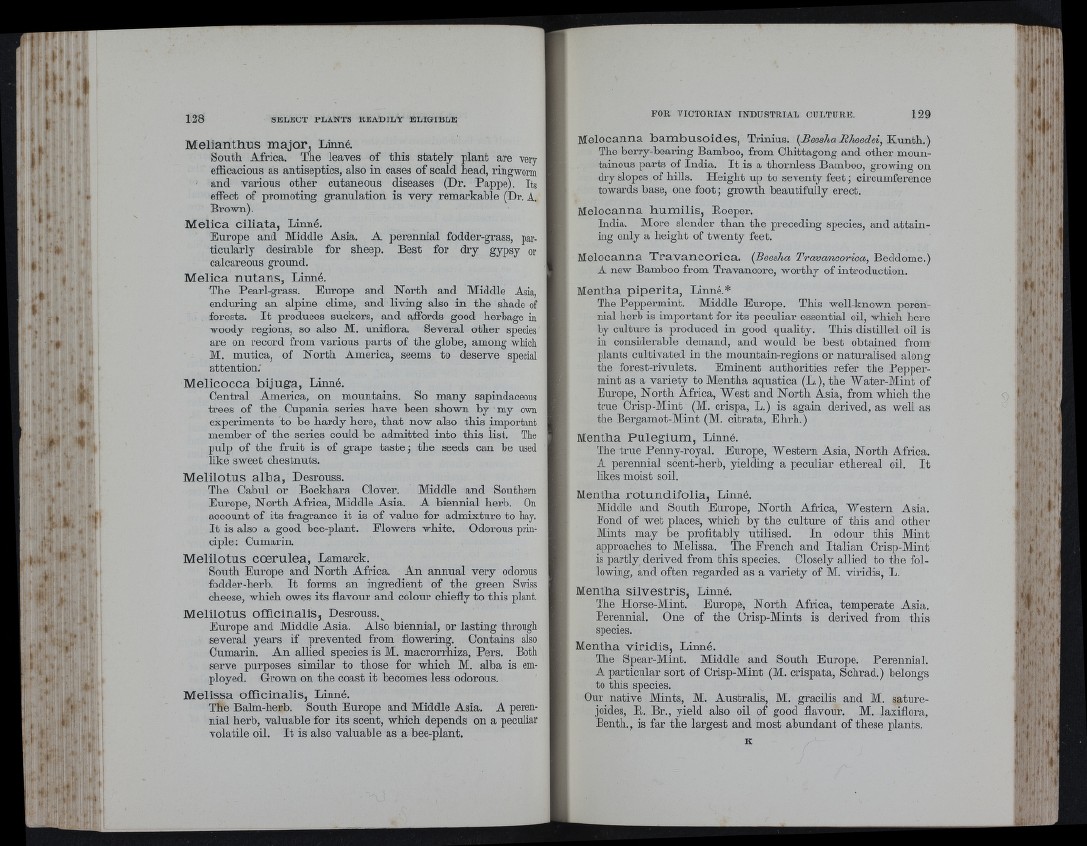
t •
I
128 SELECT PLANTS READILY ELIGIBLE
Melianthus major, Linné,
South Africa. The leaves of this stately plant are very
efficacious as antiseptics, also in cases of scald head, ringworm
and valions other cutaneous diseases (Dr. Pappe). Its
effect of promoting granulation is very remarkable (Dr. A.
Brown).
Melica ciliata, Linné.
Europe and Middle Asia. A perennial fodder-grass, particularly
desirable for sheep. Best for dry gypsy or
calcareous ground,
Melica nutans, Linné.
The Pearl-grass. Europe and North and Middle Asia,
enduring an alpine clime, and living also in the shade of
forests. I t produces suckers, and affords good herbage in
woody regions, so also M, unifiora. Several other species
are on record from various parts of the globe, among which
M, mutica, of North America, seems to deserve special
attention.
Melicocca bijuga, Linné.
Central America, on mountains. So many sapindaceous
trees of the Cupania series have been shown by my own
experiments to be bardy here, that now also this important
member of the series could be admitted into this list. The
pulp of the fruit is of grape ta ste; the seeds can be used
like sweet chestnuts,
Melilotus alba, Desronss.
The Cabul or Bockhara Clover. Middle and Southern
Europe, North Africa, Middle Asia. A biennial herb. On
account of its fragrance it is of value for admixture to hay.
I t is also a good bee-plant. Elowers white. Odorous principle:
Cumarin.
Melilotus coerulea, Lamarck.
South Europe and North Africa. An annual very odorous
fodder-herb. I t forms an ingredient of tbe green Swiss
cheese, which owes its flavour and colour chiefly to this plant.
Melilotus officinalis, Desrouss.^
Europe and Middle Asia. Also biennial, or lasting through
several yeai'S if prevented from flowering. Contains also
Cumarin. An allied species is M. macrorrhiza, Pers. Both
serve purposes similar to those for which M. alba is employed.
Grown on the coast it becomes less odorous.
Melissa officinalis, Linné.
The Balm-berb. South Europe and Middle Asia. A perennial
herb, valuable for its scent, which depends on a peculiar
volatile oil. I t is also valuable as a bee-plant.
FOR VICTORIAN INDUSTRIAL CULTURE. 129
Melocanna bambusoid.es, Trinius, {BeeshaRheedei,lL\mth.)
The berry-bearing Bamboo, from Chittagong and other mountainous
parts of India. I t is a thornless Bamboo, growing on
dry slopes of hills. Height up to seventy feet; circumference
towards base, one foot; growth beautifully erect.
Melocanna humilis, Boeper.
India. More slender than the preceding species, and attaining
only a height of twenty feet,
Melocanna Travancorica. {Beesha Travancorica, Beddome.)
A new Bamboo from Travancore, worthy of introduction.
Mentha piperita, Linné.*
The Peppermint. Middle Europe. This well-known perennial
herb is important for its peculiar essential oil, which here
by culture is produced in good quality. This distilled oil is
in considerable demand, and would be best obtained from
plants cultivated in the monntain-regions or naturalised along
the forest-rivulets. Eminent authorities refer the Peppermint
as a variety to Mentha aquatica (L.), the Water-Mint of
Europe, North Africa, West and North Asia, from which the
true Crisp-Mint (M. crispa, L.) is again derived, as well as
the Bergamot-Mint (M. citrata, Ehrh.)
I Mentha Pulegium, Linné.
The true Penny-royal, Europe, Western Asia, North Africa.
A perennial scent-herb, yielding a peculiar ethereal oil. I t
likes moist soil.
Mentha rotundifolia, Linné.
Middle and South Europe, North Africa, Western Asia.
Fond of wet places, which by the culture of this and other
Mints may be profitably utilised. In odour this Mint
approaches to Melissa. The French and Italian Crisp-Mint
is partly derived from this species. Closely allied to the following,
and often regarded as a variety of M. viridis, L.
Mentha silvestris, Linné.
The Horse-Mint, Europe, North Africa, temperate Asia.
Perennial. One of the Crisp-Mints is derived from this
species.
Mentha viridis, Linné.
The Spear-Mint. Middle and South Europe. Perennial.
A particular sort of Crisp-Mint (M. crispata, Schrad.) belongs
to this species.
Our native Mints, M. Australis, M. gracilis and M. sature-
joides, B. Br., yield also oil of good flavour. M, laxiflora,
Benth. , is far the largest and most abundant of these plants.
K
1
'«I
I
i;
• 1